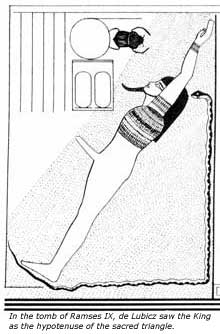Fourth Way Perspectives
Book Review
Al-Kemi: Hermetic, Occult, Political, and
Private Aspects of R. A. Schwaller de Lubicz
by André VandenBroeck
Lindisfarne Press, 286 pp.

The objective recording of the transmission of ancient knowledge from a spiritual master to a gifted student has few equals of the magnitude of P.D. Ouspensky's In Search of the Miraculous, his account of the teaching of G.I. Gurdjieff. Al-Kemi by André VandenBroeck approaches this level. For a year and a half, from 1959 through the summer of 1960, VandenBroeck was in daily contact with his mentor, R.A. Schwaller de Lubicz (1887–1961), a modern alchemist and Hermetic philosopher best known for his seminal exploration of pharaonic Egypt in such books as The Temple of Man, The Egyptian Miracle, Sacred Science, Esotericism and Symbol, and Nature Word. Like Ouspensky, VandenBroeck ends up disavowing his former teacher, but not before he gives one of the most lucid and penetrating glimpses into a knowledge as arcane as it is powerful.
Aor, as VandenBroeck refers to de Lubicz by his mystic name, meaning "Light of the Higher Intellect," is in the last cycle of his life when VandenBroeck, a thirty-five-year-old Belgian painter, seeks him out at Lou-Mas-de-Coucagno, his estate in Grasse, France. After their separation, Aor will live but a year longer. That the philosopher-scientist-artist aspects of each man are of such high degree, though VandenBroeck's are just emerging, and that both are in the serious and devoted pursuit of cosmic knowledge, is an unusual, if not extraordinary occurrence, the quality of which can only be attributed to destiny. We can have a sense of their exceptional capacities by knowing that Aor began a serious reading of medieval alchemical texts while still a teenager and later studied with Matisse, and that VandenBroeck, after a "breakthrough" read "[Bertrand Russell and [Alfred North] Whitehead's Principia Mathematica for the pleasure of it, Count Alfred Korzybski's Science and Sanity, as well as Einstein's early papers, all with enormous interest and relative ease, and mostly with the good feeling of knowing what was being discussed."
The knowledge that Aor will try to lead his student to is, as VandenBroeck says, "Pythagorean, and until de Lubicz, it had been truncated in Greece. The powerful taproot of Al-Kemi, reaching thousands of years into a fertile past, had remained buried until de Lubicz recognized its nature." This hidden field of esoteric knowledge had opened up for Aor when he visited the tomb of Ramses IX and recognized in the image of the ithyphallic pharaoh a hypotenuse of a sacred right triangle. "It was this particularly fortunate expression of the symbolique [the esoteric meaning of the symbol] which drew my attention and gave me the key to Al-Kemi. But," he added, "my perception was of number as form, and the only thing I saw at first in this figuration was the triangle 3:4:5 and the relation of 5 to 6 in the king with his raised arm."
Notes
Breakthrough. While he gives no indication of it, one wonders if this breakthrough was not engendered by a drug, much the same as we read with Ouspensky's "Experimental Mysticism" in his New Model of the Universe. This issue is raised because VandenBroeck says that with time this facility passed; that is, he could not sustain the level of vibration to understand on this level. Also, like Ouspensky, it might account for his persistent, sometimes arrogant, sense of his "individuality."
Obscurity of the text. One, of course, thinks of Gurdjieff's Legominism and those who have written commentaries, concordances and outlines. It is interesting to note that Gurdjieff said quite clearly that he intentionally "buried the bones" in the texts.

